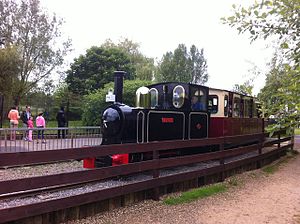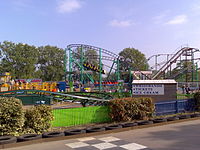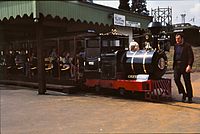Wicksteed Park
Wicksteed Park is listed park in Kettering, Northamptonshire, which includes an amusement park within its grounds. The park is located in the south-east of Kettering, on the western edge of Barton Seagrave village. The park is owned by the Wicksteed Charitable Trust, with the amusement park being run by its trading subsidiary company.
Contents
Foundation
The park was founded by Charles Wicksteed, a wealthy industrialist who owned the engineering works of Charles Wicksteed & Co. Ltd in Kettering. In 1913 he purchased the meadowland, which was part of the Barton Seagrave Hall estate, with the intention of building a model village for his workers, to be called the Barton Seagrave Garden Suburb Estate. The Wicksteed Village Trust was set up to run the enterprise. After First World War, when local authorities were building public housing, Wicksteed decided instead to create a park with leisure facilities for local people, with refreshments and attractions, for which a modest charge was made, funding the provision of a free playground and sporting facilities.[1]
The first playground equipment, manufactured by Wicksteed's company, had been installed in 1917 and an artificial lake fed by the Ise Brook was constructed in 1921, with the park officially opened that year. By 1926 the park had a pavilion and theatre building, a rose garden, a water chute, bandstand, and fountain. The water chute was designed by Charles Wicksteed and a few years later was given a new roof.[2] Barton Seagrave Hall was purchased by Charles Wicksteed in 1928. In 1931 a railway track was built around the edge of the lake. Charles Wicksteed died in 1931 and the Wicksteed Village Trust continued his work, adding features and facilities to the park.[1]
Development
The park continued to develop during the 1930s with the addition of a golf course, toy shop and aviary. A tunnel was added to the railway. The park attracted a record 40,000 visitors on August bank holiday Monday in 1935. During Second World War the park remained partially open, with American troops billeted in the pavilion. Improvement continued in the 1950s, with the opening of a cinema, a miniature car track, a pets corner and an ice cream factory. In 1969 a new office and administration block was built. The 1970s saw the addition of a nature trail, a skateboarding rink and a ferris wheel. In April 1980 the park played host to the It's a Knockout television show and also added the iconic double pirate ship. Attendance had fallen during the 1970s but had recovered to an annual 750,000 visitors by 1982. Two roller coasters, nautic jets, a cup and saucer ride and a pedal cycle monorail were added during the 1990s.[3]
Twenty-first century
Barton Seagrave Hall was sold in 2012 to help fund the park.[4]
In 2016 the water chute at Wicksteed Park was given Grade II listed building status.[2] At the end of the 2016 season, Wicksteed Park made the decision to close the double pirate ship due to high maintenance costs. The ride was sold to a businessman from Bulgaria.[5]
Wicksteed Park Railway
The 2-foot narrow gauge[6] Wicksteed Park railway is one of the features of the park. Over 15 million people have taken to its rails since it first opened in 1931. It was the last feature of the park to be added during the lifetime of the park's founder Charles Wicksteed and is supported by the Friends of the Wicksteed Park Railway.
Location
- Location map: -0.703/zoom=11 52°23’6"N, 0°42’11"W
Outside links
References
- ↑ 1.0 1.1 National Heritage List 1001524: Wicksteed Park (Register of Historic Parks and Gardens)
- ↑ 2.0 2.1 National Heritage List 1437706: Water chute at Wicksteed Park (Grade @ listing)
- ↑ Peter Scott (2002) A history of the Wicksteed Park Railway, Reading, pp. 22-32.
- ↑ "Historic Barton Seagrave Hall sold to fund Wicksteed Park". BBC News. 18 September 2012. https://www.bbc.co.uk/news/av/uk-england-northamptonshire-19636776/historic-barton-seagrave-hall-sold-to-fund-wicksteed-park.
- ↑ "Wicksteed Park's pirate ship has final swing after 34 years". BBC News. 1 November 2016. https://www.bbc.com/news/av/uk-england-northamptonshire-37829952.
- ↑ A History of the Wicksteed Park Railway - Introduction


